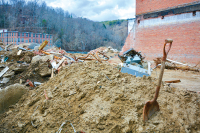AGAIN: Horrific storm damage will remake Western North Carolina
 A bouquet of flowers, likely on someone’s porch or kitchen table hours earlier, lies on a Maggie Valley sidewalk alongside other debris from Jonathan Creek. Cory Vaillancourt photo
A bouquet of flowers, likely on someone’s porch or kitchen table hours earlier, lies on a Maggie Valley sidewalk alongside other debris from Jonathan Creek. Cory Vaillancourt photo
AGAIN. For the second time in three years, Haywood County, the highest east of the Mississippi River, experienced devastating flooding from a tropical weather system that reached mountainous Southern Appalachia’s narrow, rocky canyons and broad, lush river valleys — wiping out whole towns, inundating normally impregnable areas and crippling the communications and transportation infrastructure that powers public safety, commerce and the dissemination of information.
Hurricane Helene was worse than Tropical Storm Fred in 2021. Locals say it’s even worse than 2004, when back-to-back storms a week apart led to record river crests and then-unprecedented damage. To call Helene historic would be an understatement, but the magnitude of the destruction isn’t yet clear.
What is clear is that the destruction that took place via Fred in 2021 was largely limited to the eastern reaches of Haywood County, killing six and cutting a half-billion-dollar swath of destruction through Cruso, Canton and Clyde. Helene has touched the whole of Haywood County, but across Western North Carolina, there are dozens more counties suffering the same fate or worse, as are dozens more in Florida, Georgia, South Carolina, Tennessee and Virginia. Damages could be in the tens of billions of dollars.
The human toll will be much greater, and generational, as much of the Southeast prepares for recovery, mitigation and resiliency while simultaneously preparing to deal with catastrophes like Helene again and again.
“Apocalyptic,” Canton Mayor Zeb Smathers told The Smoky Mountain News on Sept. 28. “I have searched for a better term, but it’s simply apocalyptic in every sense of the word. I suspect that is an assessment not just shared by the mayor of Canton, but the entire region of Western North Carolina. We thought 2004 was a 500-year flood. Then we heard 2021 was a 500-year flood. We made it three years until this 500-year flood.”
AGAIN. As in 2021, rainfall totals along the Blue Ridge escarpment were staggering, especially after intense rainfall from an unrelated system that began in the afternoon on Wednesday, Sept. 25. By 2 p.m. on Thursday, Sept. 26, a flood gauge from the North Carolina Flood Inundation Mapping and Alert Network (FIMAN) showed that Jonathan Creek in Maggie Valley had already measured 3.7 inches of rain in the previous 24 hours. Lake Logan Dam, upriver from Canton, had received 3.9 inches. In downtown Canton, the Pigeon River was already in minor flood stage at 12 feet and was forecast to crest as a major flood around 19 feet in the early morning hours of Friday, Sept. 27.
Related Items
Some areas closer to the South Carolina border received more than 20 inches of rain from 8 a.m. on Sept. 24 to 8 a.m. on Sept. 28, according to the National Weather Service. Hendersonville logged 21 inches. Spruce Pine, in Mitchell County, saw more than two feet. The highest recorded total so far, well away from the South Carolina border in Yancey County, was 30.78 inches.

Richland Creek, in Waynesville’s Frog Level, rose up and surrounded Giles Chemical, giving locomotives from the Blue Ridge Southern Railroad a surreal appearance while surging down Commerce Street into businesses. Cory Vaillancourt photo
Haywood County’s Cruso community, still recovering from Fred in 2021, received nearly a foot of rain. More than 11 inches of rain in Waynesville, usually barely affected by most storms, turned shallow Richland Creek in Frog Level into a raging river running right down Commerce Street and produced one of the more surreal visions of the storm thus far — two Blue Ridge Southern Railroad GP40-series locomotives, idling on submerged tracks and presenting the appearance that they were floating. The creek, now a frothing chocolatey brew smelling of petroleum products and strewn with mud, logs, propane tanks and all manner of debris, topped the bridge on Russ Avenue near the new Mountain Creek apartment complex, essentially cutting much of Waynesville off from the outside world.
The locomotives, however, weren’t the only incredible sight once the full brunt of Helene arrived hours earlier before dawn’s first light. Jonathan Creek, in Maggie Valley, was roiling. Richland Creek had already crept up to the outdoor seating areas at Frog Level Brewing in Waynesville. Hazelwood’s commercial strip was inaccessible due to deep water that flowed through yards and homes along Hazelwood Avenue.
When the rain finally stopped and floodwaters began to recede around lunchtime Friday, an even more remarkable portrait of destruction was unveiled — citizens scrambling for resources.
Some gas stations finally opened up in the late afternoon but were quickly overrun by residents riding roads stained red from the rich silty soils left behind as creeks and rivers returned to their banks. Teague’s Shell in Maggie Valley couldn’t dispense gas or process electronic payments, and at some point the store was unable even to take cash as UPC codes wouldn’t scan. From Candler to Maggie, the electronic screens on gas pumps offered only blank stares. The few stations that were able to dispense gas featured long lines hanging out onto the road, reminiscent of the 1970s energy crisis.
The failure of critical internet and cellular infrastructure around this time cast an already isolated, rural region back centuries — no phone calls, no texting, no internet, no social media, no GPS — back when the only way to engage in commerce or exchange information was in person.
“The number one issue that I’m dealing with is the lack of cellular service,” Smathers said. “It started with Verizon. It seems to go to many [providers]. I have not been able to communicate with our emergency services directly from my cell phone since approximately 9 a.m. yesterday morning until today. The idea that not just us here in Canton, Haywood County, but across Western Carolina, we cannot communicate to our citizens and our emergency management is absolutely disgraceful.”
Of course, cell phones were not the only way Canton’s leaders were able to communicate with the town’s emergency services assets, but their ubiquity has its advantages, especially for residents to learn of imminent threats or to check in on each other.
“… the idea that anybody out there — though I hope it’s not true — had the ability to rescue someone and tell their loved ones to get out and they couldn’t because their cell phone signal [was out] when we needed our communication network the most, it has at best let us down and at worst put people’s lives at risk,” Smathers said.
As residents emerged from their homes in search of food and fuel, they encountered localized destruction and obstructions from one end of Haywood County to the other.
In Maggie Valley, mud from a previous slide on Soco Road made driving conditions especially slippery. A foot-deep pool of water collected near Frankie’s Italian Trattoria, fed by a rushing stream where there didn’t used to be one: half a mile uphill, gushing in thick ropey flourishes down Mill Creek Road, which was split open and lobbing softball-sized rocks once buried three feet deep out onto Soco Road.

At least two large pools of water collected on Soco Road in Maggie Valley, making travel from one end to the other impossible for most. Mudslides, infused with twigs, logs and rocks, complicated the situation. Cory Vaillancourt photo
Near the west end of Moody Farm Road, an even larger pool of water effectively cut the valley in half. There, Jonathan Creek had roared through Parham Memorial Park, tossing tree limbs, lawn chairs, trash cans and tiny pebbles all over the sidewalk.
Waynesville Fire Chief Joey Webb said his department didn’t lose any firefighters during more than a hundred rescues from homes and vehicles, including 30 by boat, that began when the department started receiving calls around 3 a.m. on Friday. By Monday, firefighters had walked much of the fire district’s riverbanks searching for casualties, but found none. To Webb’s knowledge, there have been no fatalities in the town.

Guardrails on the Charles Street bridge over the Pigeon River in Clyde were interlaced with debris, much as they were during flooding in August 2021. Cory Vaillancourt photo
Clyde, with its compact two-block downtown in the center of Haywood County, appears to have been hit harder than in any previous flood of the modern era. This time, water from the Pigeon River rose above Carolina Boulevard. A shed was tossed against a house. Cars floated out into empty fields. Debris lined a bridge that in 2021 was studded with thick, ripe green peppers stripped from upriver fields.
Ronald Surrett, owner of Smoky Mountain Cremations and Funeral Service on Broad Street in Clyde, said his building got four feet of water in 2004, four inches in 2021 and seven feet this time. Surrett’s been in the process of moving his business to the former distillery in Maggie Valley for some time now, but on Saturday morning was still trying to salvage whatever he could.
“We wasn’t expecting this, but meanwhile, we’ll press on. We’ve not lost our homes, but we understand a lot of people has. My main concern is not the businesses, which can be relocated and get back up and going,” he said. “My main concern is for people that’s lost their homes and their family members.”
Farther east, Canton experienced a frightening escalation of the damage from both 2004 and 2021.
“Yeah, there was quite a bit more water come through,” said Canton Fire Chief Kevin Wheeler, a 30-year veteran. “The crest that I was told was 25.8 feet. In 2004, I think it was 22.8.”
Cars were overturned. Debris was strewn across mud-slicked bridges, the riverbanks again lined with those healthy green peppers. At least one building, the Moose Lodge behind BearWaters Brewing, had partially collapsed. Two huge trees, their trunks still in the Pigeon River but their tops propped against the bridge next to BearWaters, looked like they were struggling to scale it. Shards of broken glass, much more plentiful than in 2021, sparkle in testament to the ferocity with which the Pigeon assaulted surrounding structures.
At Canton’s temporary town hall — a modular structure that’s served as the seat of government since the 2021 flood damaged the old town hall on Park Street — Wheeler couldn’t confirm any fatalities as of Saturday afternoon, but said all his firefighters were tired but uninjured. His own fire department, flooded out in 2004 and 2021, is still searching for a new home up out of the water. Thanks to Sen. Thom Tillis, Wheeler has the money to do it, but the town hasn’t been able to locate a suitable parcel.

A small shed now rests about a hundred yards from where it used to sit behind Canton’s shattered riverside social hub, BearWaters Brewing. Cory Vaillancourt photo
“We had got most of what we could out, so we saved a lot of our equipment. Trucks are out,” Wheeler said. “What we had stored up beyond the highest point in 2004, up above my office, it’s all out and is now floating around.”
Canton’s police department, also housed in a temporary modular structure due to the 2021 flood, was fielding calls and operating off a Starlink terminal one of the officers had brought from home. Canton’s top administrators, Town Manager Lisa Stinnett and CFO Natalie Walker, spent at least one night on a pair of flaccid air mattresses flopped on the board room floor.
AGAIN. Like other communities across the Southeast, Canton will soon begin its recovery process from this extreme weather event. Unlike most other communities across the Southeast, Canton still hasn’t fully recovered from its last extreme weather event.
It’s hard to pinpoint how many times local leaders, including Smathers, have said the phrase “when, not if” between 2021 and last week, referring to the probability of future flooding.
One thing that Canton and Haywood County had this time around that they didn’t have in 2021 was a few days to prepare, and a few years of mitigation efforts behind them.
Smathers, his governing board and his department heads started to think seriously about Helene on Sunday, Sept. 22, and made several announcements asking people to take the storm seriously.
Haywood County Emergency Services Director Travis Donaldson said his team began planning around that same time and requested resources, like swift water rescue teams, on Tuesday, Sept. 24 — before the first raindrops even began to fall.
North Carolina Gov. Roy Cooper declared a state of emergency on Sept. 25 and said during an accompanying media briefing that he had deployed the National Guard to areas that were expected to be impacted. That same day, Haywood County Board of Commissioners Chairman Kevin Ensley and mayors from all four Haywood County municipalities — Smathers of Canton, Clyde’s Jim Trantham, Maggie Valley’s Mike Eveland and Waynesville’s Gary Caldwell — did so.
Among other things, the Haywood declaration directed the opening of emergency shelters and called for voluntary evacuations.
President Joe Biden issued a major disaster declaration for North Carolina on Sept. 29, a day after the storm. In 2021, it took more than three weeks.
It wasn’t until Sept. 30 that Haywood County first responders were able to give a live update on Facebook through a Starlink terminal.
“I’m pleased to report to you that recovering from this event is happening at a quicker pace than originally anticipated,” said Haywood County Sheriff Bill Wilke. “And that’s happening because of neighbors helping neighbors.”

Floodwaters stream down Mill Creek Road as a rainbow appears over Maggie Valley on the afternoon of Sept. 27. Cory Vaillancourt photo
Local law enforcement, Wilke said, had conducted hundreds of welfare checks and were working about 200 more. Those who aren’t located during the welfare checks are moved to another list, requiring more serious investigation, but Wilke didn’t share that number.
He did, however, announce four casualties. Names and locations of the deaths were not released.
Wilke lauded Donaldson and his team for what thus far seems to be a very low number of casualties in such a powerful storm.
Donaldson, a veteran of 2021 flooding, said that more than 350 first responders from across the country were on the ground alongside Haywood’s finest, but that the lack of cellular service had complicated things during Helene response.
“With Fred, we still had for the most part cell phone coverage throughout most of the county,” Donaldson said.
Two arrests had been made for looting, according to Wilke, who issued a stern warning against criminal activity and reminded residents that if they violated the 9 p.m. to 7 a.m. curfew, they’d most certainly encounter law enforcement.
Ensley said that roughly 13,000 residents were still without power, but crews were working diligently to reconnect as many people as possible, as quickly as possible. Although Ensley said that resources were already on their way, fuel, food, water and patience are in short supply.
“This community will be defined by our response to Hurricane Helene. Haywood County has 216 years of mountain heritage. This heritage is founded on neighbors helping neighbors, seeing each other through hard times and rejoicing in the good times,” he said. “If our response to Helene involves fighting or disregard for the law or turning on our friends and neighbors, then that’s how we’ll be defined.”
David Adams, chief of the Waynesville Police Department, lauded his fellow first responders during a Sept. 30 emergency meeting of the Waynesville Town Council but received some praise of his own, from Council Member Anthony Sutton.
“Thank you so much,” Sutton told Adams, through tears. “You rescued my family.”
Public Works Director Jeff Stines mentioned numerous issues with water and sewer, including the sewer plant, but he and his team were largely responsible for the quick end of Waynesville’s boil water order.
Luke Kinsland, director of parks and recreation, said the Waynesville Recreation Center was in good shape and that floodwaters that had raced across ballfields never reached the building. Vance Park and the Richland Creek Greenway incurred substantial damage. The dog park, Kinsland said, is a total loss but the all-abilities playground was unscathed. The armory was flooded and is closed until further notice.
Development Services Director Elizabeth Teague said her team had begun conducting flood damage assessments, street by street. Data collected during this process will help with flood insurance claims in the future.
Rob Hites, Waynesville’s town manager, said the finance department building in Hazelwood had been flooded out and that operations would be conducted in the municipal building on Main Street. Council suspended utility cutoffs for nonpayment effective Oct. 1 through Nov. 30, moved to waive fees for building permits for storm-related recovery efforts and adopted budget amendments for $500,000 each from the water, power and general fund balances for storm-related expenses.
Haywood County held an emergency meeting Oct. 1 and moved $7.5 million from fund balance to cover its own storm-related expenses.
Those appropriations are only the beginning of tens of millions of dollars that will be spent by communities across the Southeast in the coming years.
“My thinking, and our board’s thinking, and all of our thinking as citizens of Western North Carolina has to change,” Smathers said. “The Western North Carolina that existed on Thursday is no more. This is a new world of opportunities, but risks and even mitigation strategies have to be rethought.”
Tony McEwen serves as the Carolinas director of the American Flood Coalition, a bipartisan advocacy group focusing on recovery, resiliency and mitigation strategies. McEwen said that he’d spoken with local leaders in the days leading up to the storm and that the time for learning and advocacy will come in the weeks ahead but that it would be wiser — and more cost-effective — to prepare the nation’s infrastructure for increasingly frequent extreme weather events like Helene.

Flooding inundated Waynesville’s Frog Level on the afternoon of Sept. 27. Cabell Tice photo
“It would be significantly less expensive and a much better use of taxpayer dollars to invest in more resilient infrastructure now than covering these costs on the back end — not to mention, most importantly, the devastating human toll this has,” McEwen said. “We have to wake up as a nation and make significant investments to understand the level of risk our communities face now and into the future. Our infrastructure must adapt to the level of risk for tomorrow, not 50 years ago. We echo the recent findings from an exhaustive study into flood resilience undertaken by the US Chamber of Commerce — every $1 invested into flood resilience will save taxpayers $13 on the back end of flooding disasters. That figure takes into account the cost of recovery and the economic impacts faced by the communities. We don’t claim that any of this will be easy, nor cheap, but lives depend on us getting this better than we are currently.”
Smathers has also been active in the resiliency movement since 2021. Earlier this year, he spoke on a panel at an annual “waters summit” hosted by congressmen David Rouzer and Greg Murphy, who said, “If all we do is talk about this, then we should all go home.”
Remaking Western North Carolina after Hurricane Helene, however, may not produce the results some might expect.
“These businesses and these homes, including my sister’s, I can’t have an expectation that they’re coming back,” Smathers said. “That is the new reality that we are in and it’s not just shared by me — I think it’s shared by every citizen in the mountains of Western North Carolina.”













